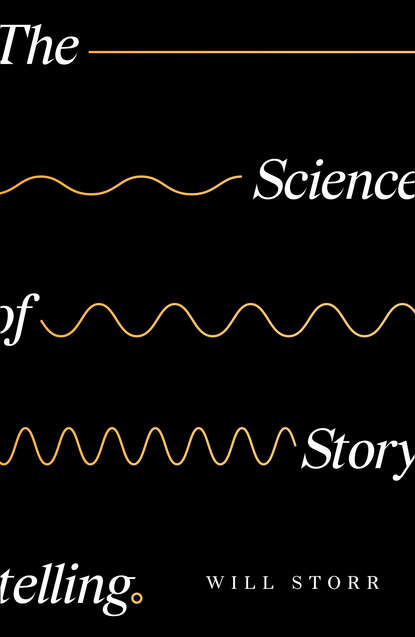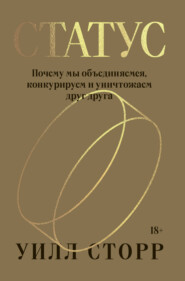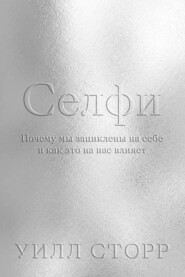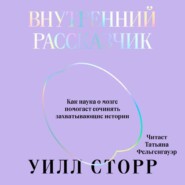По всем вопросам обращайтесь на: info@litportal.ru
(©) 2003-2024.
✖
The Science of Storytelling
Автор
Год написания книги
2019
Настройки чтения
Размер шрифта
Высота строк
Поля
The Science of Storytelling
Will Storr
Humans have been telling stories ever since we came down from the trees.But do we really understand why?And if we did, would we be able to tell them better?We would be nothing without story. Story moulds who we are, from our character to our cultural identity. Story compels us to act out our dreams and ambitions, and shapes our politics and beliefs. We use story to construct our relationships, to keep order in our law courts and governments, to make sense of the world in our newspapers and social media. Even when we sleep, we dream in story. Storytelling is an essential part of what makes us human.There have been many attempts to understand what makes a good story – from Joseph Campbell’s well-worn theories about myth and archetype to recent attempts to crack the ‘Bestseller Code’. But few have used a scientific approach. This is curious, for if we are to truly understand the machinations of storytelling, we must first come to understand the ultimate storyteller – the human brain.In this original and surprising book, Will Storr takes a scalpel to story. Leading us on a journey from the Hebrew scriptures to Mr Men, from Booker prize-winning literature to box set TV, he demonstrates how master storytellers manipulate and compel us using a dazzling display of psychological research and cutting-edge neuroscience. With the help of world leading story-analysts and brain experts, he shows how we can use this science to tell better stories – and reveals the benefits this can have on everything from our creative endeavours and careers to our happiness and wellbeing.
Copyright (#ulink_a31d1504-e925-5be5-96ac-f7c422ad6002)
William Collins
An imprint of HarperCollinsPublishers
1 London Bridge Street
London SE1 9GF
www.WilliamCollinsBooks.com (http://www.WilliamCollinsBooks.com)
This eBook first published in Great Britain by 4th Estate in 2019
Copyright © William Storr 2019
Cover design by Jack Smythe
William Storr asserts the moral right to be identified as the author of this work
A catalogue record for this book is available from the British Library
All rights reserved under International and Pan-American Copyright Conventions. By payment of the required fees, you have been granted the non-exclusive, non-transferable right to access and read the text of this e-book on-screen. No part of this text may be reproduced, transmitted, down-loaded, decompiled, reverse engineered, or stored in or introduced into any information storage and retrieval system, in any form or by any means, whether electronic or mechanical, now known or hereinafter invented, without the express written permission of HarperCollins
Source ISBN: 9780008276935
Ebook Edition © April 2019 ISBN: 9780008276959
Version: 2019-04-08
Dedication (#ulink_ba5adef4-918d-5b05-9f8c-b869d921ce18)
For my firstborn, Parker
Epigraph (#ulink_c81417bd-0ab5-5526-aef9-ea659425ff2e)
‘Ah, but a man’s reach should exceed his grasp,
Or what’s a heaven for?’
Robert Browning (1812–1889)
Contents
COVER (#u406b4d6d-8f54-5119-8f6c-927910c9a593)
TITLE PAGE (#u70d1e287-cbe1-55b3-b4e5-109639572879)
COPYRIGHT (#u4ac5d878-c673-5cb5-9e36-6535dcf51860)
DEDICATION (#u1d6969a8-8d35-5b90-aa14-cda95d8b170c)
EPIGRAPH (#ubcc6876c-a923-5742-9ec9-0ea503cf9264)
INTRODUCTION (#uff9e2ce1-4703-521e-8fcf-cc12ed8957b6)
CHAPTER ONE: CREATING A WORLD (#u321d45bf-ac86-5108-861e-a8c2a533a8b2)
1.0 Where does a story begin? (#ulink_c71de59c-e2b8-5f17-8274-80da309b7db1)
1.1 Moments of change; the control-seeking brain (#ulink_7f4d798b-0b2a-5905-a5ab-a4a19c8f91b7)
1.2 Curiosity (#ulink_a371751c-19a7-58e6-9f1c-73c2b359e372)
1.3 The model-making brain; how we read; grammar; filmic word order; simplicity; active versus passive language; specific detail; show-not-tell (#ulink_d0474c69-e453-5e17-b2b9-598fc96e43bc)
1.4 World-making in fantasy and science fiction (#ulink_bf3b00c4-9d6f-534e-bf1d-88704e55de26)
1.5 The domesticated brain; theory of mind in animism and religion; how theory-of-mind mistakes create drama (#ulink_38c1a8b8-0482-5913-8aad-5e680eb98ec9)
1.6 Salience; creating tension with detail (#ulink_b181ea2c-54e4-51eb-9c7c-6352189f2dbd)
1.7 Neural models; poetry; metaphor (#ulink_1dcfcf14-3c41-5e50-9e31-ed235a12647b)
1.8 Cause and effect; literary versus mass-market storytelling (#ulink_0822e372-df71-59fd-80a1-b4c2a88e61d4)
1.9 Change is not enough (#ulink_b6c62ef3-4c82-5eff-95e9-b82ff0482ba9)
CHAPTER TWO: THE FLAWED SELF (#u507bda99-08aa-5b76-bbbc-ba740b4eab6d)
2.0 The flawed self; the theory of control (#ulink_a7e52f61-1a53-588b-a96a-a55729d01930)
2.1 Personality and plot (#litres_trial_promo)
2.2 Personality and setting (#litres_trial_promo)
2.3 Personality and point of view (#litres_trial_promo)
2.4 Culture and character; Western versus Eastern story (#litres_trial_promo)
2.5 Anatomy of a flawed self; the ignition point (#litres_trial_promo)
2.6 Fictional memories; moral delusions; antagonists and moral idealism; antagonists and toxic self-esteem; the hero-maker narrative (#litres_trial_promo)
2.7 David and Goliath (#litres_trial_promo)
Will Storr
Humans have been telling stories ever since we came down from the trees.But do we really understand why?And if we did, would we be able to tell them better?We would be nothing without story. Story moulds who we are, from our character to our cultural identity. Story compels us to act out our dreams and ambitions, and shapes our politics and beliefs. We use story to construct our relationships, to keep order in our law courts and governments, to make sense of the world in our newspapers and social media. Even when we sleep, we dream in story. Storytelling is an essential part of what makes us human.There have been many attempts to understand what makes a good story – from Joseph Campbell’s well-worn theories about myth and archetype to recent attempts to crack the ‘Bestseller Code’. But few have used a scientific approach. This is curious, for if we are to truly understand the machinations of storytelling, we must first come to understand the ultimate storyteller – the human brain.In this original and surprising book, Will Storr takes a scalpel to story. Leading us on a journey from the Hebrew scriptures to Mr Men, from Booker prize-winning literature to box set TV, he demonstrates how master storytellers manipulate and compel us using a dazzling display of psychological research and cutting-edge neuroscience. With the help of world leading story-analysts and brain experts, he shows how we can use this science to tell better stories – and reveals the benefits this can have on everything from our creative endeavours and careers to our happiness and wellbeing.
Copyright (#ulink_a31d1504-e925-5be5-96ac-f7c422ad6002)
William Collins
An imprint of HarperCollinsPublishers
1 London Bridge Street
London SE1 9GF
www.WilliamCollinsBooks.com (http://www.WilliamCollinsBooks.com)
This eBook first published in Great Britain by 4th Estate in 2019
Copyright © William Storr 2019
Cover design by Jack Smythe
William Storr asserts the moral right to be identified as the author of this work
A catalogue record for this book is available from the British Library
All rights reserved under International and Pan-American Copyright Conventions. By payment of the required fees, you have been granted the non-exclusive, non-transferable right to access and read the text of this e-book on-screen. No part of this text may be reproduced, transmitted, down-loaded, decompiled, reverse engineered, or stored in or introduced into any information storage and retrieval system, in any form or by any means, whether electronic or mechanical, now known or hereinafter invented, without the express written permission of HarperCollins
Source ISBN: 9780008276935
Ebook Edition © April 2019 ISBN: 9780008276959
Version: 2019-04-08
Dedication (#ulink_ba5adef4-918d-5b05-9f8c-b869d921ce18)
For my firstborn, Parker
Epigraph (#ulink_c81417bd-0ab5-5526-aef9-ea659425ff2e)
‘Ah, but a man’s reach should exceed his grasp,
Or what’s a heaven for?’
Robert Browning (1812–1889)
Contents
COVER (#u406b4d6d-8f54-5119-8f6c-927910c9a593)
TITLE PAGE (#u70d1e287-cbe1-55b3-b4e5-109639572879)
COPYRIGHT (#u4ac5d878-c673-5cb5-9e36-6535dcf51860)
DEDICATION (#u1d6969a8-8d35-5b90-aa14-cda95d8b170c)
EPIGRAPH (#ubcc6876c-a923-5742-9ec9-0ea503cf9264)
INTRODUCTION (#uff9e2ce1-4703-521e-8fcf-cc12ed8957b6)
CHAPTER ONE: CREATING A WORLD (#u321d45bf-ac86-5108-861e-a8c2a533a8b2)
1.0 Where does a story begin? (#ulink_c71de59c-e2b8-5f17-8274-80da309b7db1)
1.1 Moments of change; the control-seeking brain (#ulink_7f4d798b-0b2a-5905-a5ab-a4a19c8f91b7)
1.2 Curiosity (#ulink_a371751c-19a7-58e6-9f1c-73c2b359e372)
1.3 The model-making brain; how we read; grammar; filmic word order; simplicity; active versus passive language; specific detail; show-not-tell (#ulink_d0474c69-e453-5e17-b2b9-598fc96e43bc)
1.4 World-making in fantasy and science fiction (#ulink_bf3b00c4-9d6f-534e-bf1d-88704e55de26)
1.5 The domesticated brain; theory of mind in animism and religion; how theory-of-mind mistakes create drama (#ulink_38c1a8b8-0482-5913-8aad-5e680eb98ec9)
1.6 Salience; creating tension with detail (#ulink_b181ea2c-54e4-51eb-9c7c-6352189f2dbd)
1.7 Neural models; poetry; metaphor (#ulink_1dcfcf14-3c41-5e50-9e31-ed235a12647b)
1.8 Cause and effect; literary versus mass-market storytelling (#ulink_0822e372-df71-59fd-80a1-b4c2a88e61d4)
1.9 Change is not enough (#ulink_b6c62ef3-4c82-5eff-95e9-b82ff0482ba9)
CHAPTER TWO: THE FLAWED SELF (#u507bda99-08aa-5b76-bbbc-ba740b4eab6d)
2.0 The flawed self; the theory of control (#ulink_a7e52f61-1a53-588b-a96a-a55729d01930)
2.1 Personality and plot (#litres_trial_promo)
2.2 Personality and setting (#litres_trial_promo)
2.3 Personality and point of view (#litres_trial_promo)
2.4 Culture and character; Western versus Eastern story (#litres_trial_promo)
2.5 Anatomy of a flawed self; the ignition point (#litres_trial_promo)
2.6 Fictional memories; moral delusions; antagonists and moral idealism; antagonists and toxic self-esteem; the hero-maker narrative (#litres_trial_promo)
2.7 David and Goliath (#litres_trial_promo)









